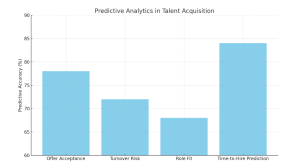As talent acquisition evolves, data is no longer just a backend metric-it’s a core business asset. In 2025, the spotlight is on predictive analytics, a powerful tool used by modern TA teams to forecast everything from offer acceptance rates to turnover risk and role fit probability.

But what exactly can you predict with confidence? And where do the limitations begin?
Let’s break it down.
1. Offer Acceptance Rate: Predictive Accuracy ~78%
AI models are getting remarkably good at predicting the likelihood that a candidate will accept an offer.
This includes:
- Salary benchmarking against similar roles
- Historical acceptance data for similar profiles
- Sentiment analysis from email or interview feedback
- Offer-to-acceptance behavior patterns by region or job function
Why it matters: Predicting this early allows recruiters to avoid wasting time on cold prospects or adjust compensation strategy dynamically.
2. Turnover Risk: Predictive Accuracy ~72%
Using machine learning and historical exit data, models can estimate the probability of a new hire leaving within 6-18 months.
Factors include:
- Past tenure patterns
- Commute distance or relocation
- Engagement signals (time to first project, manager feedback)
- Job description vs actual role alignment
Turnover prediction tools such as Workday’s Talent Insights or Visier help HR teams flag potential flight risks before problems surface.
3. Role Fit Prediction: Predictive Accuracy ~68%
This is where predictive analytics shows promise, but also its limits. Role fit predictions use:
- Resume parsing and skill match scoring
- Natural language processing on interview transcripts
- Behavioral assessments
- Peer and manager feedback calibration
However, it still struggles with variables like interpersonal dynamics, learning agility, and culture contribution-which can’t always be captured in structured data.
4. Time-to-Hire Estimation: Predictive Accuracy ~84%
This is the most mature use case of predictive hiring analytics. Based on role type, seniority, past hiring cycle times, recruiter performance, and market demand, models can project how long it will take to close a role.
Tools: ATS platforms like Greenhouse and Lever have built-in analytics dashboards that now offer these estimates out-of-the-box.
Where Predictive Analytics Struggles
Despite these advancements, predictive models are only as good as the data they’re trained on.
Common pitfalls include:
- Bias in training data: Models can replicate past hiring biases
- Lack of contextual nuance: A candidate’s mindset or potential to grow may be missed
- Untracked external factors: Life changes, industry shifts, and cultural misalignment
The SRA Take
At SRA, we use predictive analytics not to replace recruiters, but to enhance decision-making.
Our internal hiring tools combine:
- Smart matching algorithms
- Continuous feedback loops from hiring managers
- Real-time engagement tracking
We believe in the balance of technology plus human judgment. Predictive data sets the stage, but human insight delivers the performance.
Bottom Line:
Predictive analytics is transforming recruitment-but it’s not magic. It’s a tool, and like any tool, its value depends on how well you use it. The future of hiring isn’t about guessing. It’s about forecasting with confidence, adjusting with clarity, and hiring with both data and empathy.


